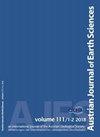The Dösen Rock Glacier in Central Austria: A key site for multidisciplinary long-term rock glacier monitoring in the Eastern Alps
IF 1.1
4区 地球科学
Q2 Earth and Planetary Sciences
引用次数: 16
Abstract
Rock glaciers are distinct landforms in high mountain environments indicating present or past permafrost conditions. Active rock glaciers contain permafrost and creep slowly downslope often forming typical flow structures with ridges and furrows related to compressional forces. Rock glaciers are widespread landforms in the Austrian Alps (c. 4600). Despite the high number of rock glaciers in Austria, only few of them have been studied in detail in the past. One of the best studied ones is the 950 m long Dösen Rock Glacier located in the Hohe Tauern Range. This rock glacier has been investigated since 1993 using a whole suite of fieldbased and remote sensing-based methods. Research focused on permafrost conditions and distribution, surface kinematics, internal structure and possible age of the landform. Results indicate significant ground surface warming of the rock glacier body during the period 2007-2015 accompanied by a general acceleration of the rock glacier surface flow velocity (max. 0.66 m/a) over the last two decades. This speed-up is possibly related to higher ice temperature and water content. As judged from various geophysical measurements, the maximum thickness of the rock glacier is about 30-40 m with an active layer of several meters depending on the location. The permafrost thickness beneath the active layer was quantified to be between 10 m (at the margins) and 40 m (at the central and upper parts). Massive sedimentary ice has not been observed or detected by geophysics so far at the central and lower part but might exist to in the rooting zone of the rock glacier as indicated from field evidences. The Dösen Rock Glacier is primarily a talus-derived rock glacier although a small glacier might have existed some times in the past in the eastern part of the rooting zone. Age estimations of the rock glacier by using the Schmidt-hammer exposure-age dating method indicate a formation period of several thousand years with alternating periods of faster and slower evolution. Research findings at this typical alpine rock glacier in the Austrian Alps clearly point out that the morphogenesis, the internal structure as well as the climaterock glacier relationship is complex but typical for such peculiar alpine landforms.________________________________________ Austrian Journal of Earth Sciences Vienna xxx xxx DOI: 10.17738/ajes.2017.0013 The Dösen Rock Glacier in Central Austria: A key site for multidisciplinary long-term rock glacier monitoring in the Eastern Alps_________________ 1)*) 1) 2) Andreas KELLERER-PIRKLBAUER , Gerhard Karl LIEB , & Viktor KAUFMANN 1) Department of Geography and Regional Science, Working Group Alpine Landscape Dynamics (ALADYN), University of Graz, Heinrichstrasse 36, 8010 Graz, Austria; 2) Institute of Geodesy, Working Group Remote Sensing and Photogrammetry, Graz University of Technology, Steyrergasse 30, 8010 Graz, Austria; *) Corresponding author, andreas.kellerer@uni-graz.at rock glacier; monitoring; flow velocity; geophysics; ground temperature; Dösen ValleyDösen奥地利中部岩石冰川:东阿尔卑斯多学科岩石冰川长期监测的关键站点
岩石冰川是高山环境中独特的地貌,表明现在或过去的永久冻土条件。活跃的岩石冰川包含永久冻土,缓慢下坡,经常形成典型的流动结构,与压缩力有关的脊和沟。岩石冰川是奥地利阿尔卑斯山脉广泛存在的地貌(约4600年)。尽管奥地利有大量的岩石冰川,但过去对其中的一些进行了详细的研究。其中一个研究得最好的是位于Hohe Tauern山脉的950米长的Dösen岩石冰川。自1993年以来,这个岩石冰川一直在使用一整套基于实地和基于遥感的方法进行调查。研究重点是冻土条件和分布、地表运动学、内部结构和地形的可能年龄。结果表明,2007-2015年期间,岩石冰川地表明显变暖,同时岩石冰川地表流速普遍加快(最大。0.66米/年)。这种加速可能与更高的冰温和水含量有关。根据各种地球物理测量结果判断,岩石冰川的最大厚度约为30-40 m,根据位置的不同,有几米的活动层。活动性层下的永久冻土厚度在10 m(边缘)和40 m(中部和上部)之间。到目前为止,地球物理尚未在中部和下部观测到大块沉积冰,但从野外证据来看,在岩石冰川的生根区可能存在大块沉积冰。Dösen岩石冰川主要为距骨型岩石冰川,但在生根带东部可能曾有过小型冰川。采用Schmidt-hammer暴露年龄测年法对岩石冰川进行的年龄估计表明,岩石冰川的形成期为几千年,并交替出现较快和较慢的演化期。奥地利阿尔卑斯山脉典型高山岩石冰川的研究结果清楚地表明,对于这种特殊的高山地貌,其形态发生、内部结构以及气候-岩石-冰川关系是复杂而典型的。________________________________________奥地利地球科学杂志维也纳xxx xxx DOI: 10.17738/ajes.2017.0013 Dösen奥地利中部岩石冰川:东阿尔卑斯山多学科岩石冰川长期监测重点站点_________________ 1)*)1)2)Andreas KELLERER-PIRKLBAUER, Gerhard Karl LIEB, & Viktor KAUFMANN 1)格拉茨大学地理与区域科学系,高山景观动力学工作组(ALADYN),奥地利格拉茨,Heinrichstrasse 36, 8010;2)格拉茨理工大学遥感与摄影测量工作组大地测量研究所,奥地利格拉茨Steyrergasse 30,8010;*)通讯作者,andreas.kellerer@uni-graz.at岩石冰川;监控;流速;地球物理学;地面温度;身上谷
本文章由计算机程序翻译,如有差异,请以英文原文为准。
求助全文
约1分钟内获得全文
求助全文
来源期刊

Austrian Journal of Earth Sciences
Earth and Planetary Sciences-Paleontology
CiteScore
3.10
自引率
0.00%
发文量
0
审稿时长
>12 weeks
期刊介绍:
AUSTRIAN JOURNAL OF EARTH SCIENCES is the official journal of the Austrian Geological, Mineralogical and Palaeontological Societies, hosted by a country that is famous for its spectacular mountains that are the birthplace for many geological and mineralogical concepts in modern Earth science.
AUSTRIAN JOURNAL OF EARTH SCIENCE focuses on all aspects relevant to the geosciences of the Alps, Bohemian Massif and surrounding areas. Contributions on other regions are welcome if they embed their findings into a conceptual framework that relates the contribution to Alpine-type orogens and Alpine regions in general, and are thus relevant to an international audience. Contributions are subject to peer review and editorial control according to SCI guidelines to ensure that the required standard of scientific excellence is maintained.
 求助内容:
求助内容: 应助结果提醒方式:
应助结果提醒方式:


